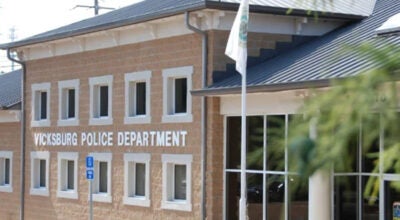Ground broken for Jackson Street center
Published 12:00 am Tuesday, November 21, 2000
Alderman Gertrude Young says the groundbreaking on Jackson Street Creative Resource Center Monday is seeing her dream become a reality. (The Vicksburg Post/MELANIE DUNCAN)
In breaking ground for the Jackson Street Creative Resource Center Monday, city officials and black leaders called for unity in support of the center and its mission.
About 50 people gathered for the ceremony on a steep incline facing the site at Jackson and Walnut streets. More than one speaker compared the seating to the uphill battle to get the center started.
What to do with the property has been a hotly debated issue for 10 years in Vicksburg, often, but not always, along racial lines.
North Ward Alderman Gertrude Young recalled the site’s past as a segregated YMCA until the 1970s in asking that divisiveness over the center be put in the past.
“Today, in the year 2000, we still have a need in this community for a safe haven for our children,” Young said. “One thing that we have now that we did not have then, is we do not have to be segregated; this center is for blacks, it’s for whites, it’s for young, it’s for old.”
Sam Habeeb, the South Ward alderman who has opposed the project as a poor use of taxpayer funds, took the opportunity of Monday’s ceremony to offer an olive branch.
“I know everybody knows I had a different opinion over this issue,” Habeeb said. “It was well debated for a number of years, but I think this is a good time for Vicksburg to move away from the debate and come together in support of this project.”
The people attending the ceremony included community leaders and several children involved in the Kings Community Center’s mentoring program.
The center will be similar in form and purpose to the center in Kings, where the city’s programs have won awards and attracted praise from state Attorney General Mike Moore.
But the new center will be a larger, brick building, not a metal building like the one in Kings, and it will feature tennis courts, a basketball court and two classrooms.
Construction is expected to cost about $1.5 million after being delayed twice because bids came in over the budget. The size of the gym was scaled back to meet the project city-set limitations.
The Kings Community Center runs on an annual budget of about $220,000. The juvenile programs are funded primarily by state grants.
The Jackson Street YMCA was built on the site as a segregated facility 70 years ago with money from the same white philanthropist, Mrs. Junius Ward Johnson, who funded the Downtown YMCA, then reserved for whites. When programs were consolidated, Y officials offered the deed to the brick structure and adjacent pool to the city. Then-Mayor Robert Walker declined the offer, citing an $800,000 price as prohibitive for transforming the dilapidated building.
The next mayor, Joe Loviza, accepted the deed and the administration announced plans to reopen the building, but it collapsed on itself as site work began. When Walker defeated Loviza to reclaim the mayor’s office, debate intensified on what to do with the site.
Many, including Habeeb and probable mayoral candidate Laurence Leyens, questioned the site as a good location for a youth center because of its limited parking and nearness to the Kings center.
Another likely candidate for mayor, Eric Rawlings, argued that the site was too closely tied to memories of segregation.
But Rawlings joined the chorus of voices in support of the center Monday, and pleaded for people to view the new facility as a “multicultural center” where blacks and whites would feel equally comfortable.
“Now that the building is being built, we need to come together and support it,” he said.
The new building will include an area in the lobby built with bricks from the YMCA building, said architect Eric Tscherter.
In the brick area, there will be several wall niches designed to display historical photos and artifacts from the original building, so future generations can remember what that facility stood for and what it meant to the community, Tscherter said.





